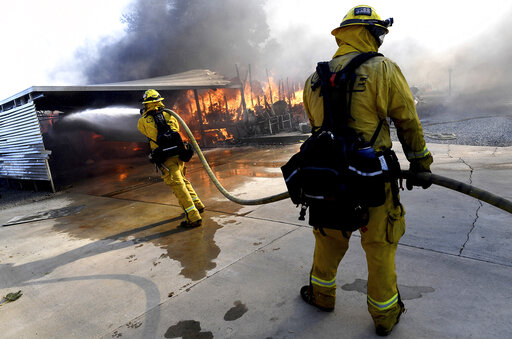While California wildfires cost property insurers billions each year, the impact of the smoke emitted by those fires may be even more costly — although scientists can’t say for sure.
The cost of wildfire impacts on human health was one of many “data gaps” identified by the California Council on Science and Technology in a new report discussed during a webinar on Thursday. The report makes an urgent call for a more systematic assessment of wildfire costs to the state as a crucial step toward determining the cost-effectiveness of mitigation measures.
“Comprehensive statewide calculation of wildfire costs is not possible with currently available data,” said Michael Wara, a senior research scholar at Stanford University and chairman of the council’s steering committee. “The cost associated with unquantified categories of wildfire loss, such as health impacts and ecosystem services, likely exceed the billions of dollars in reported costs.”
The report comes amid another severe wildfire season for the state, which prompted a call earlier this month from California’s insurance commissioner to step up efforts to protect the state’s residents from wildfires and address a pullback of private insurers from the state’s riskiest areas.
More than 5,600 firefighters are currently battling 22 wildfires in California, with 4.1 million acres burned, 31 dead and 10,488 structures destroyed this year, CalFire’s latest report shows.
Five of the top 20 largest wildfires in California history have occurred in 2020, according to CalFire.
A recent report from CoreLogic shows California is home to 76% of the residences on the top 10 list of homes at elevated risk of wildfire.
The Gordon and Betty Moore Foundation contracted with the Council on Science and Technology to develop a method of conducting a cost-benefit analysis weighing the cost of investment in solutions against the cost of “reactive management” of wildfires. The CCST’s report concluded that those costs extend far beyond the $3 billion that California spends on fire suppression each year and the $3 billion that the federal government spends on fire-suppression nationally.
Public health is one example. Wara said studies have show that the heart attack rate doubles in communities subjected to even moderate amounts of smoke from wildfires. Fires also impact “ecosystem resources,” such as the state’s water supply.
“Wildfire is no longer a problem for people in rural areas of the state,” Wara said. “It’s a statewide problem because of its incredible impacts on air quality.”
CCST researcher Teresa Feo said numerous studies are available showing the impact of wildfires on health, but none have been developed into a comprehensive cost analysis. Similarly, she said data about the cost of fire suppression is spread among multiple agencies. Presumably, “hardening” structures to better resist fire results in some return on investment, but there’s no centralized database showing those costs and the impact of the investment.
Feo said even data on the health impact of using prescribed burns as a means of reducing vegetation to control the ferocity of wildfires is lacking.
“This is a good example of why we need data,” she said. “It’s presumed that because controlled burns are under prescribed conditions, the impact can be controlled, but it’s hard to run those analyses right now.”
The report makes several recommendations:
- Policymakers must remain attuned to how climate change, land use change, and other human impacts may impact wildfire differently across the diverse regions of the state.
- The state should create a comprehensive public accounting of relevant programs to better understand the costs of wildfire mitigation activities.
- The state should consider supporting necessary research to fully assess the cost-effectiveness of prevention and mitigation activities. The research will provide an opportunity to compare these investments to costs of suppression and the losses incurred as a result of wildfire.
- The state should evaluate land use planning and urban development as an alternative strategy for preventing structure loss and increased ignitions in wildland areas.
- To understand the full costs of wildfire and the potential public health benefits of mitigation activities, as well as the tradeoffs associated with prescribed fire, the state should create a program to systematically track public health impacts from wildfire smoke, especially for vulnerable populations.
- California should create and manage a systematic, comprehensive data clearinghouse for wildfire events including wildfire smoke, prevention and mitigation, losses including health, societal and ecological impacts, and associated costs.
Wara said that wildfire losses in 2017, 2018 and this year demonstrate the urgency of the state’s problems.
“We’re seeing fires burn in California, wildfires, that are unrecognizable in their ferocity and rate of spread,” he said. “They are causing much larger disruption to the state of California than ever before.”
About the photo: In this Oct. 10, 2019, file photo, firefighters try to protect surrounding homes as they battle the Sandalwood Fire in the Villa Calimesa Mobile Home Park in Calimesa, Calif. A deadly blaze that tore through the Southern California mobile home community this month started when a trash truck caught fire and the driver dumped the burning garbage on the side the road. Now, the waste industry is reviewing longstanding guidance to drivers to dump burning trash to ensure their safety, limit truck damage and prevent explosions. (Jennifer Cappuccio Maher/The Orange County Register/SCNG via AP, File)
Was this article valuable?
Here are more articles you may enjoy.


 FEMA Denies Washington State Disaster Relief From Bomb Cyclone, Governor Says
FEMA Denies Washington State Disaster Relief From Bomb Cyclone, Governor Says  Merck Faces Patent Lawsuit Over Easier-to-Use Keytruda
Merck Faces Patent Lawsuit Over Easier-to-Use Keytruda  Survey Shows Distracted Drivers Overconfident: 20% Text While Driving, 15% Use Social Media
Survey Shows Distracted Drivers Overconfident: 20% Text While Driving, 15% Use Social Media  Report: Insurers Pay $1.6B in Dog Bite Claims, as Frequency Soars
Report: Insurers Pay $1.6B in Dog Bite Claims, as Frequency Soars 